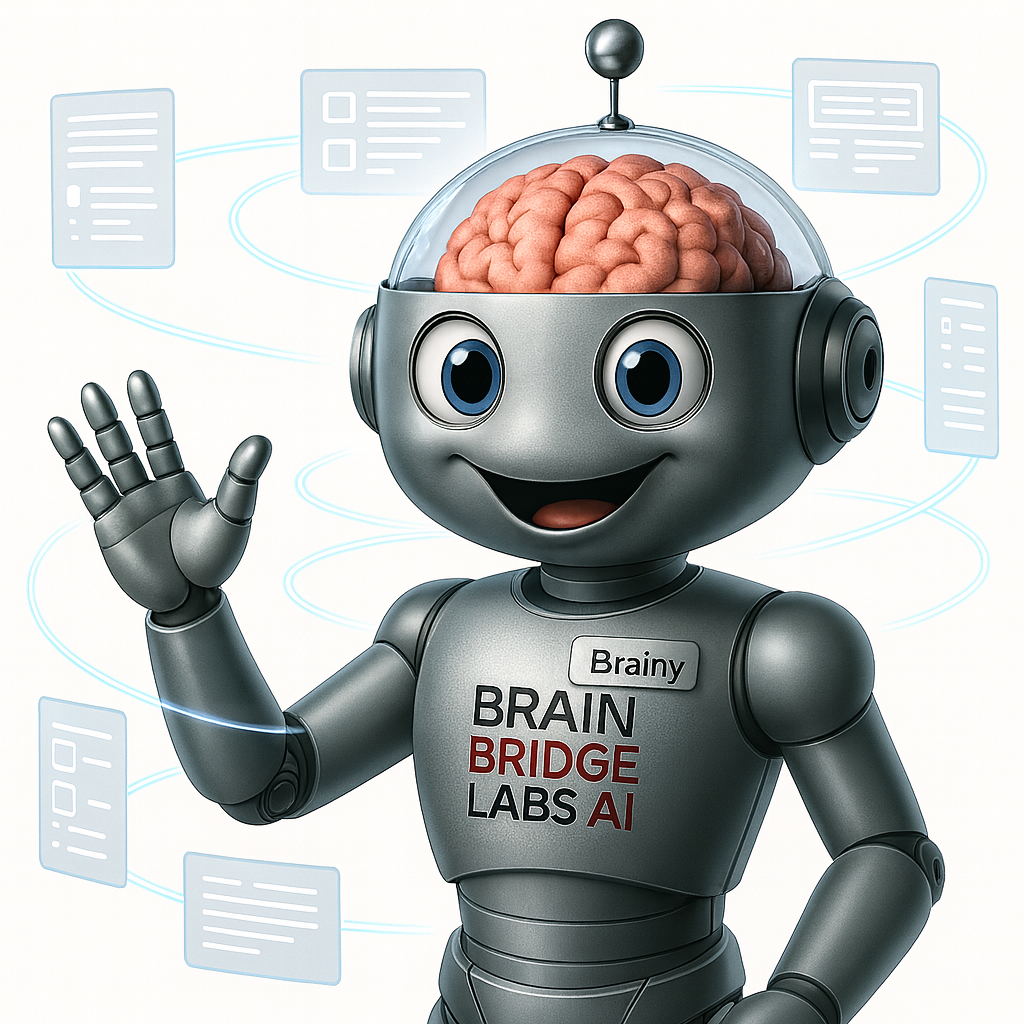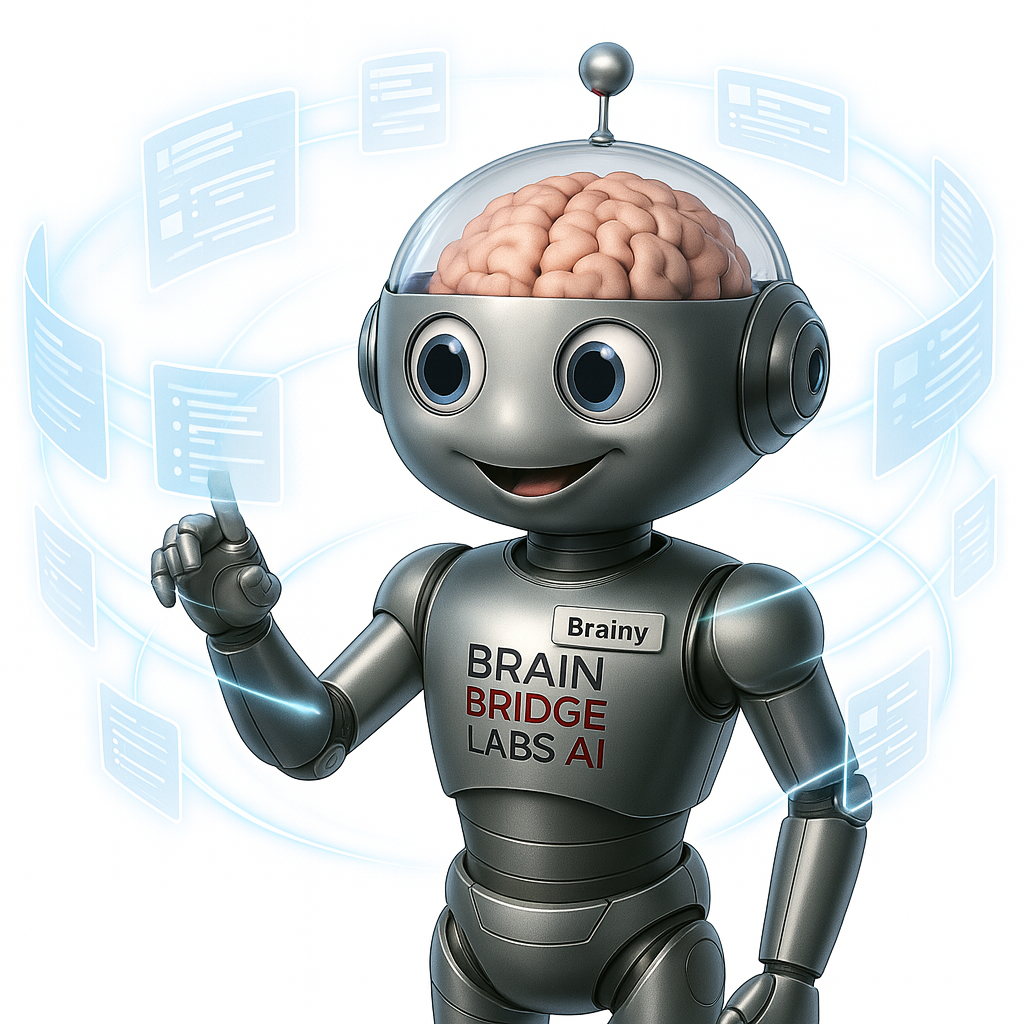INSIGHTS | Supply Chain Strategy
Supply Chain Failures Don’t Start with Bad POs.
They Start with “I Thought We Said…”
By Josh Brown, Brain Bridge CEO
Published July 15, 2025
TOPLINE
Supply chain issues don’t start with bad vendors, slow shipping, or the specs that came in wrong. The real breakdown often starts earlier… when decisions made in meetings don’t get captured clearly, shared promptly, or followed through correctly.
We’ve all been there. You’re chasing down a PO change that no one remembers approving. Stuck in an email thread trying to piece together what was said three weeks ago. You’re now making calls to vendors asking for clarification you thought was already clear. In the middle of it all, you’re expected to keep things moving without dropping the ball or blowing the budget.
This viscous cycle isn’t about incompetency. It’s about memory. For most companies, memory is fragile and scattered across people, inboxes, notes, and assumptions. That’s where risk hides, momentum stalls, and margin quietly disappears.
Core Memory Systems fix the root cause. They don’t just record conversations, they create shared operational memory across teams, tools, and time. Transcript systems solve problems upstream.
The result:
-
Fewer mistakes and re-orders
-
Faster dispute resolution with vendors
-
A searchable record of approvals, specs, and conditions
-
Less reliance on any one person to “remember what we said”
-
Higher trust across teams—and fewer fires to put out
When the system remembers, your team doesn’t have to. That’s how you avoid the $5,000 mistake that turns into a $50,000 mess. That’s how you protect margin, trust, and momentum.

Delays Don’t Originate at Receiving. They Start With a “That Should Be Fine.”
When a delivery shows up late or wrong, the blame typically lands on a familiar list: the vendor made an error, the lead time changed unexpectedly, or someone forgot to send the PO. While those are common failure points, they rarely tell the full story.
In reality, many supply chain issues begin long before a product ever hits a truck. Most breakdowns occur during quick conversations where decisions are made informally and never properly documented. In most companies, purchasing is rarely a full-time, dedicated function. Often, it is a task shared across operations, finance, or project management. A change might get casually approved in a meeting, noted mentally, and assumed to be handled, yet nothing gets logged, confirmed.
This is how problems creep in:
-
A substitution gets verbal approval on a phone or Zoom call, but no one follows up with the supplier.
-
A timeline shift is mentioned in Slack, yet the delivery date stays unchanged in the system.
-
A pricing decision is made during a hallway conversation, although the PO still reflects the outdated amount.
This isn’t carelessness. It’s how real teams move: fast, verbal, and multitasking. Everyone assumes someone followed up. No one actually did and now nobody can say with confidence what was decided, who agreed to it, or whether it was ever shared with the vendor. These situations don’t result from laziness or neglect. They happen because businesses move quickly, decisions are made verbally, and the handoffs rely too heavily on memory.
Shared memory systems step in right at that point of fragility, giving teams a clear, accessible record of what was said so small decisions don’t lead to big consequences. They sit inside the chaos and quietly track what matters by capturing approvals, flagging conditions, and building a timeline of decisions tied to each order. No more digging. No more guessing. No more margin lost because someone thought “we sent the PO.”
When Memory Fails, Your Margin Follows.
You can’t fix these breakdowns with better note-taking or another dashboard. What’s needed is infrastructure. A Core Memory System that keeps track of what was said, what was agreed to, and what still needs to happen.
That’s what the Brain Bridge Core Memory System is built for. It quietly sits inside the workflows you already use Zoom, Slack, site walks, vendor calls and captures what would otherwise get lost. Then it turns those raw conversations into structured, usable knowledge.
- Approvals are confirmed, not assumed.
- Specs are searchable, not buried.
- Decisions get surfaced, not forgotten.
Your team doesn’t need to remember who said what on which call. The system does that automatically without adding more work.
It’s not about surveillance. It’s definately not about micromanagement. It’s about removing the gaps that cost you margin, time, and trust when someone’s out, something gets missed, or a change goes undocumented.
The Core Memory System makes conversations operational so your team can move faster, follow through, and stop losing money to forgettable moments that should’ve been clear all along.

Remembering Is Not A System
When memory becomes the process, rework will be in the outcome.
The rework often costs more than the system that prevents it. Brain Bridge works with companies of any size to build AI memory infrastructure that pays for itself fast. Core Memory captures key decisions, prevents confusion, and protects your margin from forgettable mistakes. You don’t need a bigger team. You need a better system. We’ll help you build it.
Note-Takers Catch Words. They Don’t Catch Risk.
Most businesses rely on an AI notetaker and or someone in the room to take notes during meetings. Often, it’s a project manager, admin, or whoever happens to be available. That person is usually juggling multiple roles: managing vendors, tracking timelines, prepping for the next call, all while trying to capture what matters.
What those notes provide is helpful context. What they miss is risk. Risk hides in the parts of conversations that sound uncertain. Someone says, “We should be fine as long as they confirm by Friday,” or, “Let’s go with that vendor unless the freight cost comes back too high.” These are not clear approvals. They are conditional, fluid, and easy to misremember.
Here’s what happens:
-
A note says “Team agreed to move forward,” but fails to include the condition or reason that made it true.
-
Someone mentions a question about specs, yet no one flags it as unresolved.
-
A pricing exception is discussed casually and never shows up on the PO.
Teams often believe a decision was documented. What was actually recorded is a vague summary that leaves room for misinterpretation. When delays hit or shipments come in wrong, those notes won’t clarify what really happened.
A Core Memory System built for your unique purchasing flow shifts the burden. They don’t just capture the full conversation. They identify the decisions with operational weight. They surface conditional approvals, open items, and assumptions that need confirmation. Teams no longer rely on memory or interpretation. They work from facts.

Your Purchasing Team Deserves a Supply Chain Memory
In most mid-sized companies, purchasing is not managed by a large, specialized department. It’s often handled by a few individuals, or even a single person, juggling quotes, vendor coordination, approvals, and invoices alongside other operational responsibilities.
That kind of environment relies heavily on speed and trust. What it often lacks is a consistent, shared memory. Email threads get buried. Verbal approvals never make it into the purchase order. Critical context from vendor calls disappears when someone is off that day. The same questions surface repeatedly: “Did we agree to that spec change?” or “Was that price final or just a placeholder?”
A supply chain memory helps eliminate this confusion. Rather than forcing teams to learn a brand new system, it works alongside how they already operate. It captures decisions, preserves conversations, and ensures clarity across every touchpoint.
In a well-supported system:
-
Project conversations are automatically recorded and tied to vendors or purchase orders.
-
Key decisions, conditions, and follow-ups are identified clearly without relying on someone to take notes.
-
Anyone can search for what was said instead of waiting for someone else to clarify it.
-
Every team member works from the same factual record.
This shift doesn’t just make purchasing more efficient. It reduces uncertainty, strengthens communication, and prevents small missteps from becoming costly problems. A shared memory removes guesswork and brings clarity into the day-to-day.
Every System Works Great. Until the Buyer Goes on Vacation.
In many mid-sized companies, purchasing processes rely more on institutional knowledge than formal systems. That knowledge often sits with one person: the buyer. When that person is available, things tend to flow. Vendors get quick responses, project managers confirm details easily, and purchase orders go out without hesitation.
Once the buyer is out, the wheels start to wobble.
- A supplier calls to check if freight was included.
- A project lead needs to confirm whether the spec was changed to stainless or left as galvanized.
- The field team wants to know if delivery is heading to the site or being staged somewhere else.
No one wants to guess, and no one wants to be wrong. So the team starts digging—through inboxes, shared drives, Slack threads, and scribbled notes, hoping to piece together what was actually decided. This is where momentum stalls. Time gets wasted, trust erodes, and costly mistakes start creeping in.
A transcript capture and analysis system eliminates this fragility by capturing the actual conversations and tying them to the job. Instead of depending on one person to remember everything, the team works from a shared record that holds the full context. Work keeps moving. Decisions don’t disappear. The business stays aligned, even when key people step away.
When Only One Person Knows, Everyone Holds the Risk.
When context lives in someone’s head, the whole system becomes fragile.
Purchasing processes shouldn’t fall apart when someone’s out sick. Brain Bridge can help you build a shared supply chain memory so every quote, approval, and spec is accessible when and where it matters. It’s not just about tracking. It’s about trust, speed, and protecting your margin from the next avoidable mistake.


You Can’t Audit What You Didn’t Capture
Most purchasing problems are not the result of laziness. They happen because the paper trail never existed in the first place.
A decision gets made during a vendor call, although no one documents it. A pricing exception is offered with specific conditions, yet those conditions never make it into the PO. Someone verbally approves a change, assuming it will be followed up in writing, but it never is.
Once an issue surfaces whether it involves cost, schedule, or quality, teams often scramble to recreate the history. Emails get forwarded. Slack threads get revisited. People try to remember exactly what was said and when. Each person has a version of the truth, but no one has proof.
Without a clear record, decisions become assumptions. Timelines get blurred. Accountability becomes subjective. This isn’t just an operational gap. It becomes a business risk. Finance can’t validate why a vendor was paid more. Operations can’t identify where the process broke down. Leadership can’t track patterns or enforce accountability because the data simply isn’t there.
Core Memory Systems provide what traditional workflows lack. They capture full conversations, flag important decisions, and allow anyone to pull up a definitive answer. Questions like, “Did we approve this?” or “Was that the agreed delivery schedule?” stop being debates and start being searches.
Once that memory exists, teams can work faster, audit smarter, and build trust across roles without relying on selective memory or best guesses.
The Vendor Who Swore You Approved It
Every purchasing team eventually runs into the same situation. A vendor sends the wrong material, delivers too early, or substitutes a part. When the issue is flagged, they claim it was approved.
At that point, your team faces a choice. You can delay the project to sort it out or absorb the cost and move forward. Either decision impacts margin.
These miscommunications are not always dramatic. In most cases, they result from overlooked details. Someone gave a verbal approval that was misunderstood. A follow-up email never went out. A change was discussed but not finalized. Mistakes like these chip away at profit. They don’t show up as one large loss. They show up as rework, delays, and damage to vendor relationships.
A Core Memory System helps you avoid these situations by giving your team an accurate record of what was said. When a disagreement arises, your team can verify exactly how the conversation went. If a substitution was discussed but not approved, you will know. If a delivery condition was tied to a budget confirmation, it will be clear.
The return is measurable:
-
Fewer disputes with vendors
-
Fewer unplanned costs from incorrect shipments
-
Faster resolution when questions come up
-
Stronger position during negotiations, supported by documented facts
Every avoided mistake protects margin. Every confirmed decision reduces risk. When your team has a reliable record of key conversations, you spend less time reacting to problems and more time moving the project forward with confidence.
When the System Remembers, People Don’t Have to Cover Themselves
Most breakdowns in purchasing do not happen because people are careless. They happen because teams are forced to rely on memory and scattered notes. In that kind of environment, people start working defensively.
Instead of trusting the process, they start covering themselves. Emails are written to document conversations after the fact. Multiple people get copied just to avoid being blamed later. Meetings are scheduled to re-confirm what was already said. These actions are not signs of a bad culture. They are symptoms of a system that people do not fully trust.
When information is fragile, stress goes up. People hesitate to make decisions. Relationships between departments become strained. Everyone wastes time trying to protect themselves instead of pushing the work forward. A transcript system helps break that pattern. By capturing conversations in full and surfacing what matters, it removes the fear of being misunderstood or misquoted. The team no longer needs to over-document, over-communicate, or overthink every decision.
The result is more than just operational clarity. It is cultural stability. People relax into their roles because they know the system will back them up. Teams trust each other more because everyone works from the same facts. Leaders gain confidence because decisions are traceable and repeatable. Work becomes less about guarding your reputation and more about doing the right thing. That shift lowers stress, improves morale, and creates the kind of culture that attracts high performers instead of burning them out.
Final Word: Supply Chain Clarity Starts With Listening
Most supply chain problems do not come from bad people or bad tools. They come from conversations that fade, details that get misremembered, and decisions that were never captured in a way the whole team could trust.
High-performing teams do more than talk things through. They build systems that hold onto what was said so that nothing critical gets lost. A transcript system offers more than just documentation. It becomes part of how the business operates. It connects purchasing, operations, and finance with a common source of truth. It eliminates confusion, reduces rework, and eases the pressure that comes from trying to keep everything straight. This approach allows people to focus on execution. The worry about whether something was approved, documented, or shared disappears. The system already knows.
Solving communication gaps does not require more meetings. It does not require another layer of software that adds complexity. What teams need is a reliable memory that keeps track of the details without asking anyone to remember them perfectly. This is how mid-sized teams stop firefighting and start operating with clarity. Margin is protected. Trust is built. Stress goes down.
When conversations are captured, decisions get followed through. That’s how supply chains stay strong.


